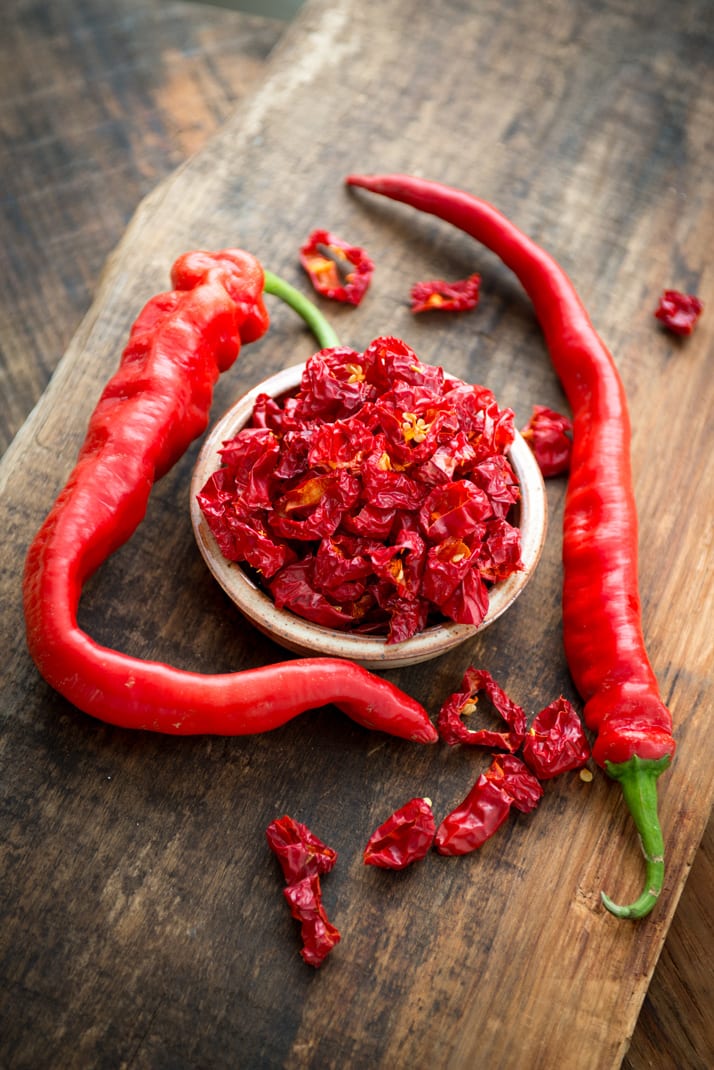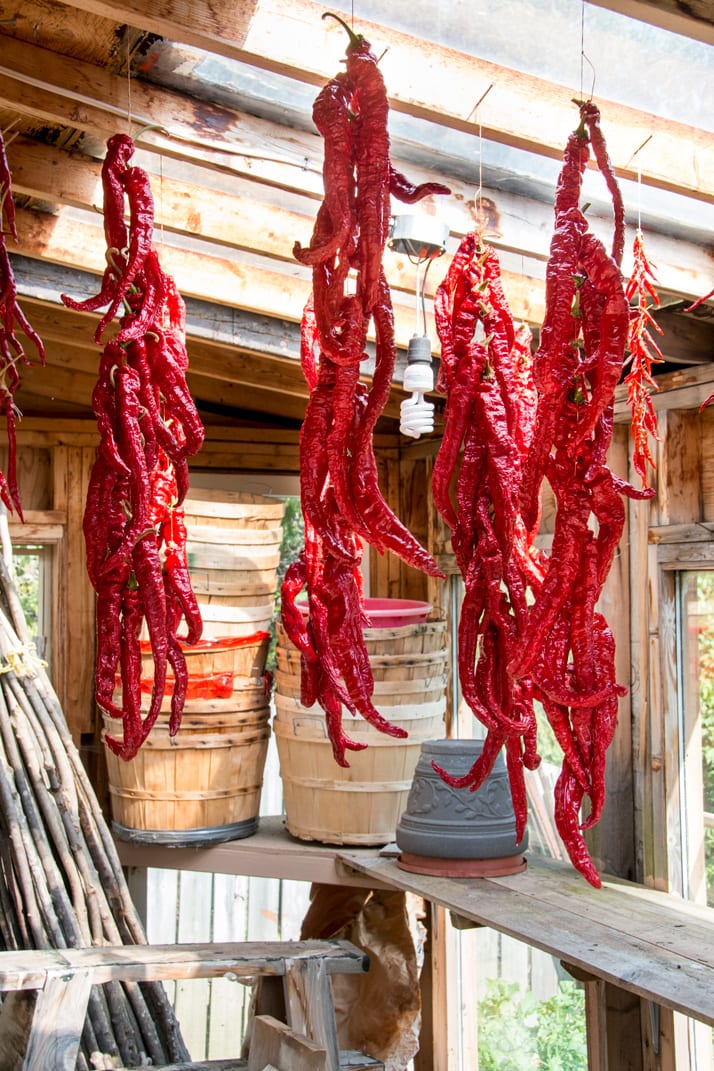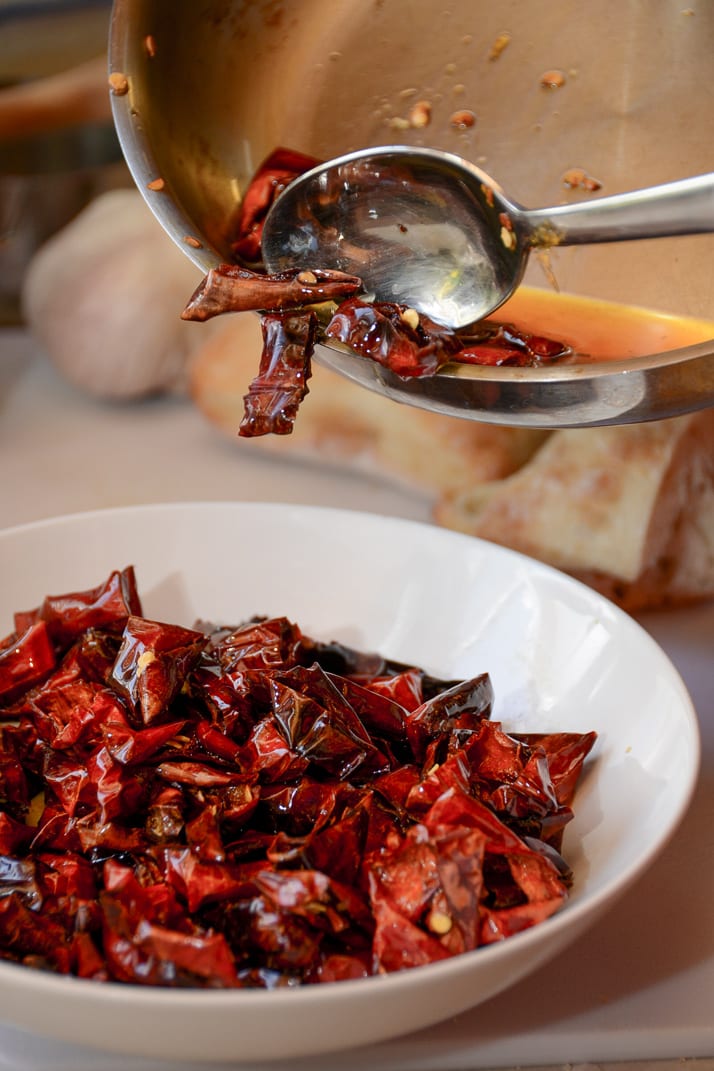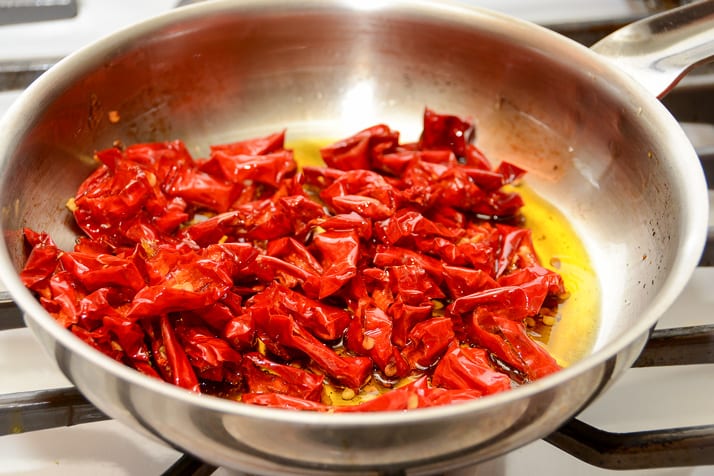
This DIY dried hot peppers post is a must-read for any lover of hot foods and peppers! The first time I was introduced to these peppers, I was pregnant with my first child. I normally like hot and spicy food, but while I was pregnant, my tolerance sky rocketed and I was eating these like chips! At first, the ladies that prepared them, warned me that they were hot and might upset my stomach. But then once they realized how much I loved them, actually craved them, they always made sure to save me some because as superstition goes, you don’t deny a craving when you’re pregnant or your child will have a birthmark that somehow resembles the food that you are craving!!
Most people do not associate hot and spicy with Italian food but truth be told, Italians love their hot peppers. In the very southern parts of Italy, where my family is from, you will see peppers adorning balconies more so than flowers! They are enjoyed on a daily basis either fresh, dried or in oil.
This particular way of preserving them came to us from Nonna Anna who is from the central part of Italy. Sweet peppers such as red sheppard, work just as well.
Once dried, these peppers store really well so you’ll want to make sure you have enough for the entire winter! They are amazing all on their own or as an accompaniment to add both heat and flavour to pasta dishes, meats, and sandwiches. One of my favourite treats is frying an egg in the leftover oil the next morning, delicious and gets you going!
We have been told that the best peppers to do this with are the Portuguese hot pepper which is a very long and narrow pepper about an inch in diameter at the stem and sometimes reaching 12 inches in length. If you have your own preferred hot pepper you can definitely use them as well. You want to wait until they are completely red in colour but still firm like the one on the far right in the picture below, which in southern Ontario, Canada, is in late August to Early October.
There are a few options when it comes to drying them. One is to use a food dehydrator. Follow the manufacturer’s recommendations as far as temperature and amount of drying time. You will want to check them periodically to rotate and remove any that are done. They should be dry enough so that when you gently shake them, they ‘sound’ dry or make a clinking sound. Don’t let them dry out too much though. Another method is to use an oven that is capable of temperatures as low as 120 – 135 degrees F. And finally, the more traditional method of drying peppers is to string them together like a necklace by sewing kitchen twine through the stems.
This method is only consistent and advisable in hot and dry climates. For our purposes, we are using the dehydrator and oven methods.
Using a Dehydrator:
Start by washing your peppers thoroughly and drying them completely. Prepare your racks. Cut the peppers into 1/2 – 3/4 inch rings and place on your racks. Be sure not to overcrowd them to allow for good airflow. Turn on the dehydrator and follow the manufacturer’s recommendation for drying time and temperature. You will need to check them periodically for doneness. Smaller rings will dry out quicker and you can remove those ones. This process can take about 8-12 hours depending on your dehydrator. Once they are done, place them in food-safe airtight containers or bags and store in the freezer.
Using an Oven:
Preheat your oven to 120 – 130 degrees F. Thoroughly wash and dry your peppers. Cut the peppers into 1/2-3/4 inch rings and place on a baking sheet. Put the baking sheet in the oven and check often to see which are done. You will want to flip the peppers over throughout the drying time. If you do not have a convection oven, leave the oven door open slightly. If the temperature reaches higher than 140 degrees F, you run the risk of slowly cooking them rather than drying them.
Once dried, you simply put the dried pepper rings in food-safe airtight bags or containers and store in the freezer. Again, they should ‘clink’ when shaken to know if you have dried them enough.
To fry the dried pepper rings:
Place 1/4 cup of olive oil in a small frying pan over medium-low heat. Immediately add 1 cup of dried peppers and use a spoon to continuously stir and flip them over. Once the oil begins to heat up you will notice the peppers starting to puff up a bit. They will change colour slightly as well and from this point, it will take only a couple of minutes. As soon as you see that the colour starts to turn from vibrant red to a deep burgundy or brown remove them with a slotted spoon or they will quickly burn. Sprinkle with salt while hot. Leftover peppers can be stored in a bowl in the refrigerator covered with food safe plastic wrap and they will remain crispy this way.
As an option, you can add a couple cloves of garlic while preparing the peppers but be sure to remove them as soon as they start to colour otherwise they will impart a burnt and bitter garlic flavour to the oil.











loretta bell
27.08.2016 at 17:01As a lover of all things hot, thank you for this idea. Was just musing about exactly this subject. My question: we have a variety of peppers (jalapenos, hungarian yellow hots, mystery peppers X, poblano, anaheim, etc). some of these never go red. Wondering if you wait for them to age on the vine or can you pick them and age them off the vine?
Thoroughly enjoy your posts and some day hope to get to Italy. Thank You!
Angela DeSalvo
20.09.2016 at 23:04Hi Loretta, so sorry for taking this long to get back to you but we were asking a few different Nonna’s about this. The consensus is that you can dry any pepper, it shouldn’t matter what colour it is. Hot peppers, however, usually reach their highest heat level when fully mature. In the case of the breeds that turn red, the colour change is just a way of knowing when they are mature. As for aging off the vine, if you pick it too tender or young and leave it to ripen off the vine there is a good chance it will rot before ripening. If you pick them when they are close to turning colour or ripening then yes, they will continue to mature off the vine. Hope this helps, let us know if we can clarify further.
loretta
20.10.2016 at 16:22What a lovely and timely surprise to find your response in my email! Just reviewed the drying peppers article and will now commence drying using both the oven method and the dehydrator. I have dried peppers in the traditional string manner while living in Tucson, but hesitate to try this method where we live now in the Inland Northwest of Washington state.
Thanks to all the Nonna’s much for answering my question!
Joel MacCharles
24.10.2016 at 15:15Love your photography and love how you are sharing multiple means to get to the same ending – as well as how to use it! We’ve had success air-driying thinner peppers (such as Thai chilies) inside in Ontario in the summer but also love our deyhdrator…
Found your site after the awesome weekend at Food Bloggers of Canada and really love what you are doing (the sardines also look amazing)…
🙂 Joel
Angela DeSalvo
24.10.2016 at 16:04Thanks Joel! It was great meeting you at the conference. We are big fans of your site and book!